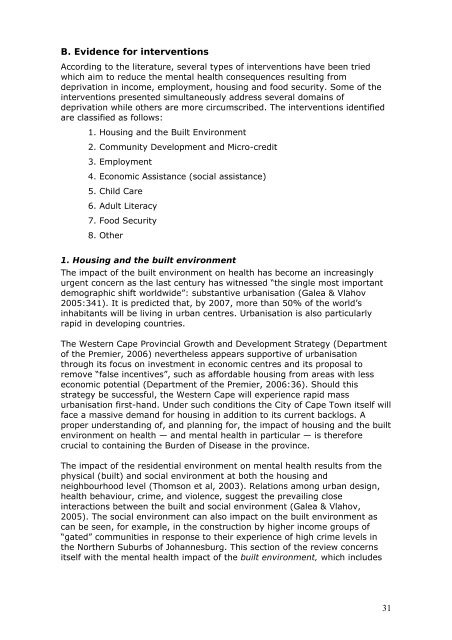(Volume 4) - Mental Health Disorders - Vula - University of Cape Town
(Volume 4) - Mental Health Disorders - Vula - University of Cape Town
(Volume 4) - Mental Health Disorders - Vula - University of Cape Town
Create successful ePaper yourself
Turn your PDF publications into a flip-book with our unique Google optimized e-Paper software.
B. Evidence for interventionsAccording to the literature, several types <strong>of</strong> interventions have been triedwhich aim to reduce the mental health consequences resulting fromdeprivation in income, employment, housing and food security. Some <strong>of</strong> theinterventions presented simultaneously address several domains <strong>of</strong>deprivation while others are more circumscribed. The interventions identifiedare classified as follows:1. Housing and the Built Environment2. Community Development and Micro-credit3. Employment4. Economic Assistance (social assistance)5. Child Care6. Adult Literacy7. Food Security8. Other1. Housing and the built environmentThe impact <strong>of</strong> the built environment on health has become an increasinglyurgent concern as the last century has witnessed “the single most importantdemographic shift worldwide”: substantive urbanisation (Galea & Vlahov2005:341). It is predicted that, by 2007, more than 50% <strong>of</strong> the world’sinhabitants will be living in urban centres. Urbanisation is also particularlyrapid in developing countries.The Western <strong>Cape</strong> Provincial Growth and Development Strategy (Department<strong>of</strong> the Premier, 2006) nevertheless appears supportive <strong>of</strong> urbanisationthrough its focus on investment in economic centres and its proposal toremove “false incentives”, such as affordable housing from areas with lesseconomic potential (Department <strong>of</strong> the Premier, 2006:36). Should thisstrategy be successful, the Western <strong>Cape</strong> will experience rapid massurbanisation first-hand. Under such conditions the City <strong>of</strong> <strong>Cape</strong> <strong>Town</strong> itself willface a massive demand for housing in addition to its current backlogs. Aproper understanding <strong>of</strong>, and planning for, the impact <strong>of</strong> housing and the builtenvironment on health — and mental health in particular — is thereforecrucial to containing the Burden <strong>of</strong> Disease in the province.The impact <strong>of</strong> the residential environment on mental health results from thephysical (built) and social environment at both the housing andneighbourhood level (Thomson et al, 2003). Relations among urban design,health behaviour, crime, and violence, suggest the prevailing closeinteractions between the built and social environment (Galea & Vlahov,2005). The social environment can also impact on the built environment ascan be seen, for example, in the construction by higher income groups <strong>of</strong>“gated” communities in response to their experience <strong>of</strong> high crime levels inthe Northern Suburbs <strong>of</strong> Johannesburg. This section <strong>of</strong> the review concernsitself with the mental health impact <strong>of</strong> the built environment, which includes31

















